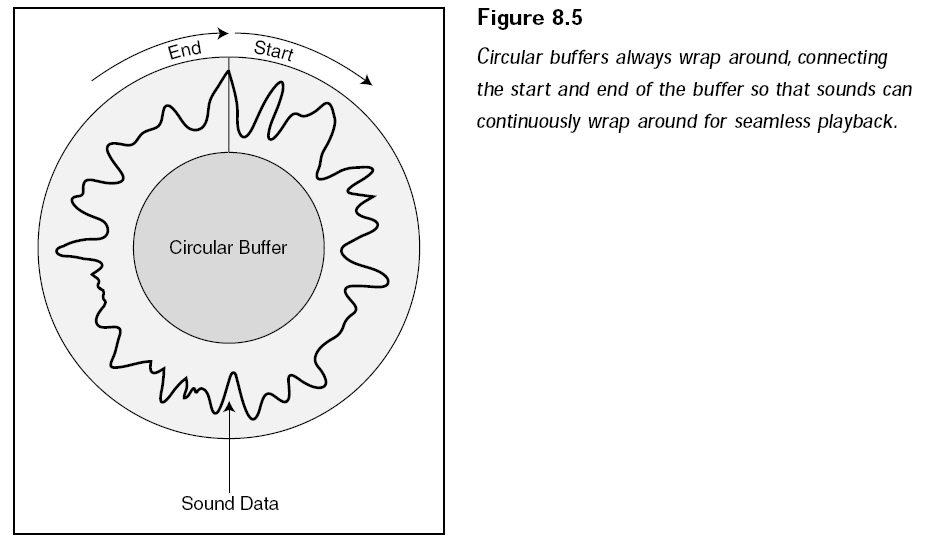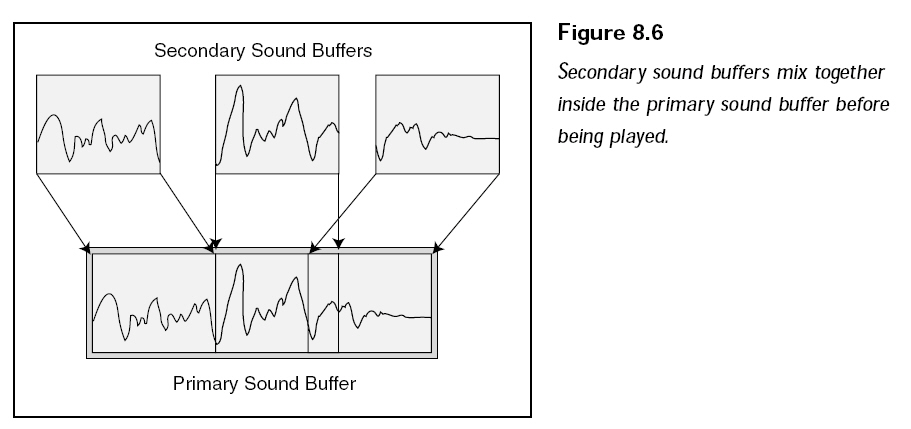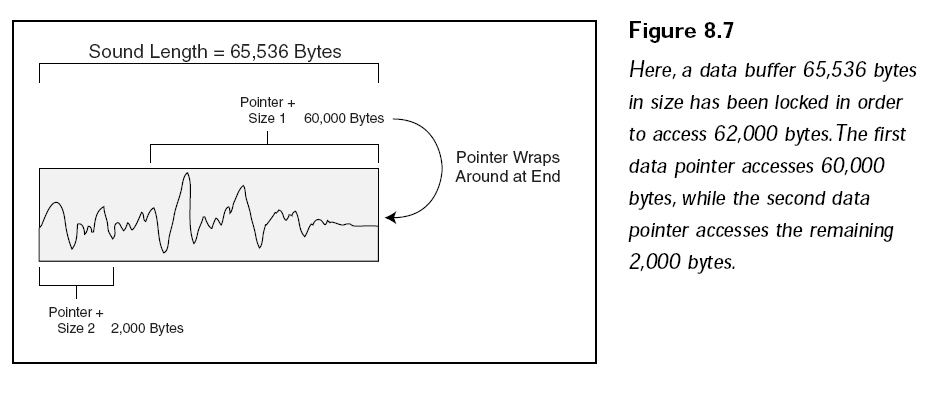用DirectX Audio和DirectShow播放声音和音乐(2)
来源:互联网 发布:java如何连接局域网 编辑:程序博客网 时间:2024/04/29 22:52
本篇是用DirectXAudio和DirectShow播放声音和音乐(1)的续篇。
开始使用主音频缓存
让缓存在程序启动的时候开始播放可以节省不少处理器时间。因为内存资源是有限的,特别是在硬件设备中,而你使用的数据缓存可能需要任意大小,因此主音频缓冲区和辅助缓冲区使用环形缓存。
环形缓冲的示意图如下:

因为数据缓冲是一个一维数组,所以可以让这个缓冲区头尾相接。这是一个十分强大的技术,利用这个技术我们可以节省大量的内存。
声音在进行混音处理后,被送入环形主音频缓存。一旦播放位置到达主音频缓存的终点,声音又从头开始播放,这样声音就被无间隙地连续播放。如果想要使用缓存的这种循环特性,需要指定启用循环播放的特性,若不然当播放到缓冲区终点时,播放就停止了。
为了播放缓存中的音频数据(在开启循环选项的情况下播放),需要调用Play函数。
The Play method causes the soundbuffer to play, starting at the play cursor.
HRESULT Play(
DWORD dwReserved1,
DWORD dwPriority,
DWORD dwFlags
);Parameters
- dwReserved1
- Reserved. Must be 0.
- dwPriority
- Priority for the sound,used by the voice manager when assigning hardware mixing resources. Thelowest priority is 0, and the highest priority is 0xFFFFFFFF. If the bufferwas not created with the DSBCAPS_LOCDEFER flag, this value must be 0.
- dwFlags
- Flags specifying how toplay the buffer. The following flags are defined:
Looping flag
Value Description DSBPLAY_LOOPING After the end of the audio buffer is reached, play restarts at the beginning of the buffer. Play continues until explicitly stopped. This flag must be set when playing a primary buffer.Voice allocation flags
- The voice allocation flagsare valid only for buffers created with the DSBCAPS_LOCDEFER flag. One ofthe following flags can be used to force the processing of the sound intohardware or software. If neither DBSPLAY_LOCHARDWARE nor DBSPLAY_LOCSOFTWAREis set, the sound is played in either software or hardware, depending on theavailability of resources at the time the method is called. See Remarks.
Value Description DSBPLAY_LOCHARDWARE Play this voice in a hardware buffer only. If the hardware has no available voices and no voice management flags are set, the call to IDirectSoundBuffer8::Play fails. This flag cannot be combined with DSBPLAY_LOCSOFTWARE. DSBPLAY_LOCSOFTWARE Play this voice in a software buffer only. This flag cannot be combined with DSBPLAY_LOCHARDWARE or any voice management flag.Voice management flags
- The voice management flagsare valid only for buffers created with the DSBCAPS_LOCDEFER flag, and areused for sounds that are to play in hardware. These flags enable hardwareresources that are already in use to be yielded to the current sound. Onlybuffers created with the DSBCAPS_LOCDEFER flag are candidates for prematuretermination. See Remarks.
Value Description DSBPLAY_TERMINATEBY_TIME If the hardware has no available voices, a currently playing nonlooping buffer will be stopped to make room for the new buffer. The buffer prematurely terminated is the one with the least time left to play. DSBPLAY_TERMINATEBY_DISTANCE If the hardware has no available voices, a currently playing buffer will be stopped to make room for the new buffer. The buffer prematurely terminated will be selected from buffers that have the buffer's DSBCAPS_ MUTE3DATMAXDISTANCE flag set and are beyond their maximum distance. If there are no such buffers, the method fails. DSBPLAY_TERMINATEBY_PRIORITY If the hardware has no available voices, a currently playing buffer will be stopped to make room for the new buffer. The buffer prematurely terminated will be the one with the lowest priority as set by the dwPriority parameter passed to IDirectSoundBuffer8::Play for the buffer.
Return Values
If the method succeeds, thereturn value is DS_OK. If the method fails, the return value may be one of thefollowing error values:
Return code DSERR_BUFFERLOST DSERR_INVALIDCALL DSERR_INVALIDPARAM DSERR_PRIOLEVELNEEDED
当完成主音频缓存设置后(以及整个音响系统),如果想停止它,需要调用IDirectSoundBuffer::Stop。
The Stop method causes the soundbuffer to stop playing.
HRESULT Stop();Parameters
None.
Return Values
If the method succeeds, thereturn value is DS_OK. If the method fails, the return value may be one of thefollowing error values:
Remarks
For secondary sound buffers,IDirectSoundBuffer8::Stop sets the play cursor to the sample that follows thelast sample played. This means that when the Play method is next called on thebuffer, it will continue playing where it left off.
For the primary buffer, if anapplication has the DSSCL_WRITEPRIMARY level, this method will stop the bufferand reset the play cursor to 0 (the beginning of the buffer). This is necessarybecause the primary buffers on most sound cards can play only from the beginningof the buffer.
However, ifIDirectSoundBuffer8::Stop is called on a primary buffer and the application hasa cooperative level other than DSSCL_WRITEPRIMARY, this method simply reversesthe effects of IDirectSoundBuffer8::Play. It configures the primary buffer tostop if no secondary buffers are playing. If other buffers are playing in thisor other applications, the primary buffer will not actually stop until they arestopped. This method is useful because playing the primary buffer consumesprocessing overhead even if the buffer is playing sound data with the amplitudeof 0 decibels.
使用辅助音频缓存
想要使用辅助音频缓存的数据,需要将辅助音频缓存中包含的数据填充到主音频缓存,如下图所示:

如果在主音频缓存的同一区域写入两段音频数据,这两段声音就会被同时播放。辅助音频缓存使用 IDirectSoundBuffer8接口,这个接口和IDirectSoundBuffer十分类似,实际上如果想要创建IDirectSoundBuffer8接口,必须先创建IDirectSoundBuffer接口,然后通过请求新接口来获取IDirectSoundBuffer8接口。
创建辅助音频缓存和创建主音频缓存时主要的不同是必须在初始化时设置回放格式,这意味着缓冲区只能使用一种格式。如果希望使用另外的格式,必须释放当前的缓存,重新创建另外一个。
代码示例:
// creates and initializes an object that supports the IDirectSound8 interface
if(FAILED(DirectSoundCreate8(NULL, &g_ds, NULL)))
{
MessageBox(NULL, "Unable to create DirectSound object", "Error", MB_OK);
return 0;
}
// set the cooperative level of the application for this sound device
g_ds->SetCooperativeLevel(g_hwnd, DSSCL_NORMAL);
// create a sound buffer
// setup the WAVEFORMATEX structure
WAVEFORMATEX wave_format;
ZeroMemory(&wave_format, sizeof(WAVEFORMATEX));
wave_format.wFormatTag = WAVE_FORMAT_PCM;
wave_format.nChannels = 1; // mono
wave_format.nSamplesPerSec = 11025;
wave_format.wBitsPerSample = 16;
wave_format.nBlockAlign = (wave_format.wBitsPerSample / 8) * wave_format.nChannels;
wave_format.nAvgBytesPerSec = wave_format.nSamplesPerSec * wave_format.nBlockAlign;
// setup the DSBUFFERDESC structure
DSBUFFERDESC ds_buffer_desc;
// zero out strcutre
ZeroMemory(&ds_buffer_desc, sizeof(DSBUFFERDESC));
ds_buffer_desc.dwSize = sizeof(DSBUFFERDESC);
ds_buffer_desc.dwFlags = DSBCAPS_CTRLVOLUME;
ds_buffer_desc.dwBufferBytes = wave_format.nAvgBytesPerSec * 2; // 2 seconds
ds_buffer_desc.lpwfxFormat = &wave_format;
// create the fist version object
if(FAILED(g_ds->CreateSoundBuffer(&ds_buffer_desc, &ds, NULL)))
{
// error ocuurred
MessageBox(NULL, "Unable to create sound buffer", "Error", MB_OK);
}
else
{
// get the version 8 interface
ds->QueryInterface(IID_IDirectSoundBuffer8, (void**)&g_ds_buffer);
// release the original interface
ds->Release();
}
锁定和加载 --- 在缓冲区中加载数据
缓存接口有一对处理数据加载的函数。 IDirectSoundBuffer8::Lock函数锁定音频缓冲数据,并且找回指向缓冲区数据的数据指针;IDirectSoundBuffer8::Unlock释放在锁定操作中使用的资源。
当锁定缓存以后,就能对缓冲区进行写入操作。先告诉缓冲写入偏移量的字节数、写入位置、要写入数据的字节数,写入完成后返回两个指向数据的指针以及写入数据的字节数。为什么会有两个指针和两个数据大小呢?因为音频数据缓冲区是环形的,写入的数据也需要跨过起始位置。返回的第一个指针是请求的位置,第一个值是从请求的位置到结束所写入的字节数,第二个指针通常是缓存区的起始位置,第二个值是从起点开始写入的字节数。
这里有一个长度是65536字节大小的缓冲区,这个缓冲区被锁定,以便于写入62000字节的数据。第一个指针处写入了60000字节,第二个指针处还剩下2000字节,如下图所示:
Lock函数使用信息如下:
The Lock method readies all orpart of the buffer for a data write and returns pointers to which data can bewritten.
HRESULT Lock(
DWORD dwOffset,
DWORD dwBytes,
LPVOID * ppvAudioPtr1,
LPDWORD pdwAudioBytes1,
LPVOID * ppvAudioPtr2,
LPDWORD pdwAudioBytes2,
DWORD dwFlags
);Parameters
- dwOffset
- Offset, in bytes, from thestart of the buffer to the point where the lock begins. This parameter isignored if DSBLOCK_FROMWRITECURSOR is specified in the dwFlags parameter.
- dwBytes
- Size, in bytes, of theportion of the buffer to lock. The buffer is conceptually circular, so thisnumber can exceed the number of bytes between dwOffset and the end of thebuffer.
- ppvAudioPtr1
- Address of a variable thatreceives a pointer to the first locked part of the buffer.
- pdwAudioBytes1
- Address of a variable thatreceives the number of bytes in the block at ppvAudioPtr1. If this value isless than dwBytes, the lock has wrapped and ppvAudioPtr2 points to a secondblock of data at the beginning of the buffer .
- ppvAudioPtr2
- Address of a variable thatreceives a pointer to the second locked part of the capture buffer. If NULLis returned, the ppvAudioPtr1 parameter points to the entire locked portionof the capture buffer.
- pdwAudioBytes2
- Address of a variable thatreceives the number of bytes in the block at ppvAudioPtr2. If ppvAudioPtr2is NULL, this value is zero.
- dwFlags
- Flags modifying the lockevent. The following flags are defined:
Value Description DSBLOCK_FROMWRITECURSOR Start the lock at the write cursor. The dwOffset parameter is ignored. DSBLOCK_ENTIREBUFFER Lock the entire buffer. The dwBytes parameter is ignored.
Return Values
If the method succeeds, thereturn value is DS_OK. If the method fails, the return value may be one of thefollowing error values:
Return code DSERR_BUFFERLOST DSERR_INVALIDCALL DSERR_INVALIDPARAM DSERR_PRIOLEVELNEEDEDRemarks
This method accepts an offsetand a byte count, and returns two write pointers and their associated sizes. Ifthe locked portion does not extend to the end of the buffer and wrap to thebeginning, the second pointer, ppvAudioBytes2, receives NULL. If the lock doeswrap, ppvAudioBytes2 points to the beginning of the buffer.
If the application passes NULLfor the ppvAudioPtr2 and pdwAudioBytes2 parameters, the lock extends no furtherthan the end of the buffer and does not wrap.
After writing data to thepointers returned by this method, the application must immediately call Unlockto notify DirectSound that the data is ready for playback. Failure to do so cancause audio breakup or silence on some sound device configurations.
This method returns writepointers only. The application should not try to read sound data from thispointer, because the data might not be valid. For example, if the buffer islocated in on-card memory, the pointer might be an address to a temporary bufferin system memory. When IDirectSoundBuffer8::Unlock is called, the contents ofthis temporary buffer are transferred to the on-card memory.
以下这段代码锁定辅助音频缓冲区,并且填充随机数据。
char* ptr;
DWORD size;
// readies all or part of the buffer for a data write and returns pointers to which data can be written
if(SUCCEEDED(g_ds_buffer->Lock(0, 0, (void**)&ptr, &size, NULL, 0, DSBLOCK_ENTIREBUFFER)))
{
for(DWORD i = 0; i < size; i++)
ptr[i] = rand() % 256;
}
填充完数据后,应该给缓冲区解锁,调用IDirectSoundBuffer8::Unlock解锁。
The Unlock method releases alocked sound buffer.
HRESULT Unlock(
LPVOID pvAudioPtr1,
DWORD dwAudioBytes1,
LPVOID pvAudioPtr2,
DWORD dwAudioBytes2
);Parameters
- pvAudioPtr1
- Address of the valueretrieved in the ppvAudioPtr1 parameter of the Lock method.
- dwAudioBytes1
- Number of bytes written tothe portion of the buffer at pvAudioPtr1. See Remarks.
- pvAudioPtr2
- Address of the valueretrieved in the ppvAudioPtr2 parameter of the IDirectSoundBuffer8::Lockmethod.
- dwAudioBytes2
- Number of bytes written tothe portion of the buffer at pvAudioPtr2. See Remarks.
Return Values
If the method succeeds, thereturn value is DS_OK. If the method fails, the return value may be one of thefollowing error values:
Return code DSERR_INVALIDCALL DSERR_INVALIDPARAM DSERR_PRIOLEVELNEEDEDRemarks
An application must pass bothpointers, pvAudioPtr1 and pvAudioPtr2, returned by the IDirectSoundBuffer8::Lockmethod to ensure the correct pairing of IDirectSoundBuffer8::Lock andIDirectSoundBuffer8::Unlock. The second pointer is needed even if nothing waswritten to the second pointer.
The values in dwAudioBytes1 anddwAudioBytes2 must specify the number of bytes actually written to each part ofthe buffer, which might be less than the size of the lock. DirectSound usesthese values to determine how much data to commit to the device.
以下代码解锁刚才锁定的辅助音频缓冲区:
g_ds_buffer->Unlock(ptr, size, NULL, 0);
播放缓冲区中的声音
在辅助音频缓冲区中播放音频和在主音频缓冲区中播放是一样的,惟一不同的是这次需要设置播放的起始位置,通过IDirectSoundBuffer8::SetCurrentPosition来设置。一般情况下,会选择从缓冲的开头播放,需要注意的是,停止播放一段音频并不会重置播放位置,所以可以通过停止播放来达到暂停的目的,只需要再次调用播放函数来恢复播放。
The SetCurrentPosition methodsets the position of the play cursor, which is the point at which the next byteof data is read from the buffer.
HRESULT SetCurrentPosition(
DWORD dwNewPosition
);Parameters
- dwNewPosition
- Offset of the play cursor,in bytes, from the beginning of the buffer.
Return Values
If the method succeeds, thereturn value is DS_OK. If the method fails, the return value may be one of thefollowing error values:
Return code DSERR_INVALIDCALL DSERR_INVALIDPARAM DSERR_PRIOLEVELNEEDEDRemarks
This method cannot be called onthe primary buffer.
If the buffer is playing, thecursor immediately moves to the new position and play continues from that point.If it is not playing, playback will begin from the new position the next timethe Play method is called.
改变音量
DirectSound在播放声音时按照采样时的最大音量播放,加之受限于音频硬件,所以没有办法让音量变得更大,DirectSound只能让音量变得更小些。这是通过减小声音级别来完成的,这个级别的单位是百分之一分贝。范围从0(最大音量)--10000(无声),利用这个特性可以在程序中加入“淡入”或“淡出“的效果。
要调整音量,可以使用 IDirectSoundBuffer8::SetVolume函数。
The SetVolume method sets theattenuation of the sound.
HRESULT SetVolume(
LONG lVolume
);Parameters
- lVolume
- Attenuation, in hundredthsof a decibel (dB).
Return Values
If the method succeeds, thereturn value is DS_OK. If the method fails, the return value may be one of thefollowing error values:
Return code DSERR_CONTROLUNAVAIL DSERR_GENERIC DSERR_INVALIDPARAM DSERR_PRIOLEVELNEEDEDRemarks
Allowable values are betweenDSBVOLUME_MAX (no attenuation) and DSBVOLUME_MIN (silence). These values aredefined in Dsound.h as 0 and ?10,000 respectively. The value DSBVOLUME_MAXrepresents the original, unadjusted volume of the stream. The valueDSBVOLUME_MIN indicates an audio volume attenuated by 100 dB, which, for allpractical purposes, is silence. DirectSound does not support amplification.
以下给出一个完整示例来运用刚才学到的知识。
点击下载源码和工程
源码示例:
PURPOSE:
Lock Load Playing Demo
***************************************************************************************/
#define DIRECTINPUT_VERSION 0x0800
#include <windows.h>
#include <stdio.h>
#include <dsound.h>
#include "resource.h"
#pragma comment(lib, "dxguid.lib")
#pragma comment(lib, "dsound.lib")
#pragma warning(disable : 4996)
#define Safe_Release(p) if((p)) (p)->Release();
// window handles, class and caption text.
HWND g_hwnd;
char g_class_name[] = "LockLoadClass";
IDirectSound8* g_ds; // directsound component
IDirectSoundBuffer8* g_ds_buffer; // sound buffer object
//--------------------------------------------------------------------------------
// Window procedure.
//--------------------------------------------------------------------------------
long WINAPI Window_Proc(HWND hwnd, UINT msg, WPARAM wParam, LPARAM lParam)
{
switch(msg)
{
case WM_DESTROY:
PostQuitMessage(0);
return 0;
}
return (long) DefWindowProc(hwnd, msg, wParam, lParam);
}
//--------------------------------------------------------------------------------
// Main function, routine entry.
//--------------------------------------------------------------------------------
int WINAPI WinMain(HINSTANCE inst, HINSTANCE, LPSTR cmd_line, int cmd_show)
{
WNDCLASS win_class;
MSG msg;
IDirectSoundBuffer* ds = NULL;
// create window class and register it
win_class.style = CS_HREDRAW | CS_VREDRAW;
win_class.lpfnWndProc = Window_Proc;
win_class.cbClsExtra = 0;
win_class.cbWndExtra = DLGWINDOWEXTRA;
win_class.hInstance = inst;
win_class.hIcon = LoadIcon(inst, IDI_APPLICATION);
win_class.hCursor = LoadCursor(NULL, IDC_ARROW);
win_class.hbrBackground = (HBRUSH) (COLOR_BTNFACE + 1);
win_class.lpszMenuName = NULL;
win_class.lpszClassName = g_class_name;
if(! RegisterClass(&win_class))
return FALSE;
// create the main window
g_hwnd = CreateDialog(inst, MAKEINTRESOURCE(IDD_LOCKLOAD), 0, NULL);
ShowWindow(g_hwnd, cmd_show);
UpdateWindow(g_hwnd);
// initialize and configure directsound
// creates and initializes an object that supports the IDirectSound8 interface
if(FAILED(DirectSoundCreate8(NULL, &g_ds, NULL)))
{
MessageBox(NULL, "Unable to create DirectSound object", "Error", MB_OK);
return 0;
}
// set the cooperative level of the application for this sound device
g_ds->SetCooperativeLevel(g_hwnd, DSSCL_NORMAL);
// create a sound buffer
// setup the WAVEFORMATEX structure
WAVEFORMATEX wave_format;
ZeroMemory(&wave_format, sizeof(WAVEFORMATEX));
wave_format.wFormatTag = WAVE_FORMAT_PCM;
wave_format.nChannels = 1; // mono
wave_format.nSamplesPerSec = 11025;
wave_format.wBitsPerSample = 16;
wave_format.nBlockAlign = (wave_format.wBitsPerSample / 8) * wave_format.nChannels;
wave_format.nAvgBytesPerSec = wave_format.nSamplesPerSec * wave_format.nBlockAlign;
// setup the DSBUFFERDESC structure
DSBUFFERDESC ds_buffer_desc;
// zero out strcutre
ZeroMemory(&ds_buffer_desc, sizeof(DSBUFFERDESC));
ds_buffer_desc.dwSize = sizeof(DSBUFFERDESC);
ds_buffer_desc.dwFlags = DSBCAPS_CTRLVOLUME;
ds_buffer_desc.dwBufferBytes = wave_format.nAvgBytesPerSec * 2; // 2 seconds
ds_buffer_desc.lpwfxFormat = &wave_format;
// create the fist version object
if(FAILED(g_ds->CreateSoundBuffer(&ds_buffer_desc, &ds, NULL)))
{
// error ocuurred
MessageBox(NULL, "Unable to create sound buffer", "Error", MB_OK);
}
else
{
// get the version 8 interface
ds->QueryInterface(IID_IDirectSoundBuffer8, (void**)&g_ds_buffer);
// release the original interface
ds->Release();
// lock buffer, fill with random values, and unlock.
char* ptr;
DWORD size;
// readies all or part of the buffer for a data write and returns pointers to which data can be written
if(SUCCEEDED(g_ds_buffer->Lock(0, 0, (void**)&ptr, &size, NULL, 0, DSBLOCK_ENTIREBUFFER)))
{
for(DWORD i = 0; i < size; i++)
ptr[i] = rand() % 256;
}
// releases a locked sound buffer
g_ds_buffer->Unlock(ptr, size, NULL, 0);
// play sound looping
// sets the position of the play cursor,
// which is the point at which the next byte of data is read from the buffer.
g_ds_buffer->SetCurrentPosition(0);
// set the attenuation of the sound
g_ds_buffer->SetVolume(DSBVOLUME_MAX);
// causes the sound buffer to play, starting at the play cursor.
g_ds_buffer->Play(0, 0, DSBPLAY_LOOPING);
}
// start message pump, waiting for signal to quit.
ZeroMemory(&msg, sizeof(MSG));
while(msg.message != WM_QUIT)
{
if(PeekMessage(&msg, NULL, 0, 0, PM_REMOVE))
{
TranslateMessage(&msg);
DispatchMessage(&msg);
}
}
// release directsound objects
g_ds->Release();
UnregisterClass(g_class_name, inst);
return (int) msg.wParam;
}
运行截图:
阅读下篇:用DirectXAudio和DirectShow播放声音和音乐(3)
- 用DirectX Audio和DirectShow播放声音和音乐
- 用DirectX Audio和DirectShow播放声音和音乐(2)
- 用DirectX Audio和DirectShow播放声音和音乐(2)
- 用DirectX Audio和DirectShow播放声音和音乐(6)
- 用DirectX Audio和DirectShow播放声音和音乐(7)
- 用DirectX Audio和DirectShow播放声音和音乐(5)
- 用DirectX Audio和DirectShow播放声音和音乐(4)
- 用DirectX Audio和DirectShow播放声音和音乐(3)
- 用DirectX Audio和DirectShow播放声音和音乐(1)
- 用DirectX Audio和DirectShow播放声音和音乐(1)
- 用DirectX Audio和DirectShow播放声音和音乐(3)
- 用DirectX Audio和DirectShow播放声音和音乐(4)
- 用DirectX Audio和DirectShow播放声音和音乐(5)
- 用DirectX Audio和DirectShow播放声音和音乐(6)
- 用DirectX Audio和DirectShow播放声音和音乐(7)
- 利用DirectShow播放音乐和视频
- audio的音乐播放器的播放和暂停
- Js控制HTML5 Audio 音乐播放和关闭
- 网上流传的一面试题目
- 自动关机批处理命令(超简单好用)
- 3W+2H:学习和思考问题的有效方式
- 用DirectX Audio和DirectShow播放声音和音乐(1)
- 看房注意事项备注
- 用DirectX Audio和DirectShow播放声音和音乐(2)
- PCLint使用介绍
- 关于RFID、物联网方案整理想法归纳之 (一)
- MATLAB基本矩阵函数
- Oracle中常用的函数
- 2010 回归线
- 程序员需要更强的沟通协调能力-对普通员工、有效的沟通能力可能比技术能力更重要
- 始遠
- 精进不休 .NET 4.0 (1) - asp.net 4.0 新特性之web.config的改进, ViewStateMode, ClientIDMode, EnablePersistedSelection, 控件的其它一些改进


